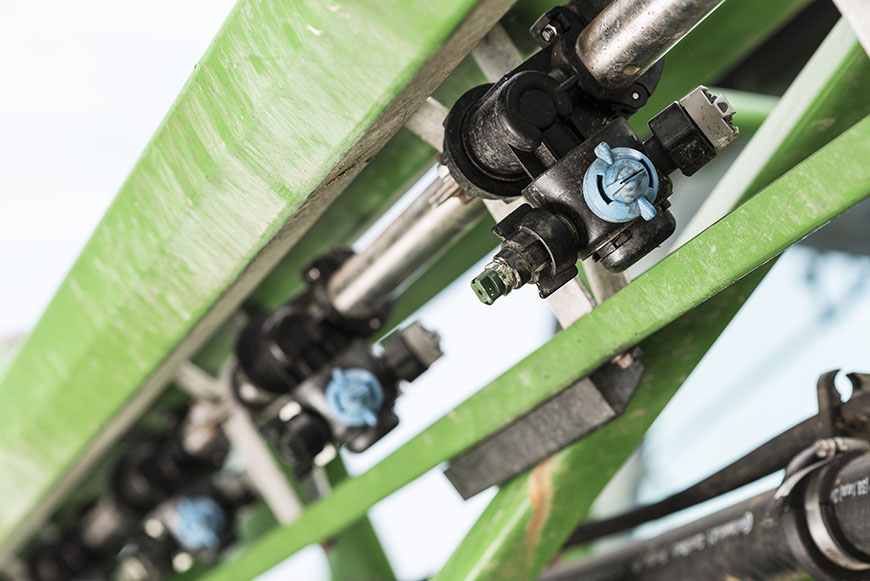Tips for Early-Season Spraying

Are you confident that you’re getting the most out of your spray investments? Here are some tips to help you start off right and stay on track with your nozzle selection and tank-mixing regimen.
1. Understand product labels. Particularly with the regulations surrounding this year’s new dicamba-tolerant soybeans, it’s important to pay attention to nozzle or spray pressure restrictions as well as any setback restrictions from sensitive areas.
2. Minimize drift. Drift potential can be alleviated by using the correct nozzle at the right pressure for spraying certain products. For example, the Turbo TeeJet® flat-fan nozzle generates a smaller droplet. The Turbo TeeJet® Induction (TTI) nozzle for dicamba gives you a larger, heavier droplet that has more velocity to continue down to the target without a high potential to drift or float away in the wind. It’s hard to find one nozzle that can satisfy different demands, so use multiple nozzles to best manage your spray droplet size and control drift.
You can also help minimize drift by adding the correct adjuvant to your tank mix. Adjuvants help reduce the amount of fine particles in the spray, get more crop protection product on the target and help it stay there.
3. Don’t reduce coverage. Although large droplets are less likely to drift, they can also reduce coverage, which can be a negative when your objective is to eliminate certain weeds. Large droplets are not so bad for dicamba herbicides, but they can be challenging for dicamba tank-mix partners or herbicides that specialize in eliminating volunteer corn. These chemistries perform better when coverage is broader.
4. Keep your sprayer clean. If you use dry flowable herbicides, it takes a lot of agitation to get them completely dissolved and to keep them in suspension or in solution. If they don’t dissolve, they can get hung up in screens, caked up in strainers or caught up in the end caps of spray booms. Be sure to check your sprayer for residue, and clean it out promptly.
5. Be mindful of mixing order. Most label directions call for starting off with at least half a tank of water, then adding dry flowables or water-soluble products, followed by liquid products, then emulsifiable concentrates. We all know that mixing order is important, but sometimes it’s hard to give it the attention it needs in the heat of a busy growing season.
However, adding products slowly and giving them ample time to agitate, dissolve and become well-mixed greatly increases your chances of having a successful tank mix without incompatibility issues. I always like to remind applicators that the solution to pollution is dilution.
Check out The Deal With Yield® farming podcast for more in-season insights like these.
The Deal With Yield is a registered trademark of Winfield Solutions, LLC.
TeeJet is a registered trademark of TeeJet Technologies.
© 2017 Winfield Solutions, LLC
1. Understand product labels. Particularly with the regulations surrounding this year’s new dicamba-tolerant soybeans, it’s important to pay attention to nozzle or spray pressure restrictions as well as any setback restrictions from sensitive areas.
2. Minimize drift. Drift potential can be alleviated by using the correct nozzle at the right pressure for spraying certain products. For example, the Turbo TeeJet® flat-fan nozzle generates a smaller droplet. The Turbo TeeJet® Induction (TTI) nozzle for dicamba gives you a larger, heavier droplet that has more velocity to continue down to the target without a high potential to drift or float away in the wind. It’s hard to find one nozzle that can satisfy different demands, so use multiple nozzles to best manage your spray droplet size and control drift.
You can also help minimize drift by adding the correct adjuvant to your tank mix. Adjuvants help reduce the amount of fine particles in the spray, get more crop protection product on the target and help it stay there.
3. Don’t reduce coverage. Although large droplets are less likely to drift, they can also reduce coverage, which can be a negative when your objective is to eliminate certain weeds. Large droplets are not so bad for dicamba herbicides, but they can be challenging for dicamba tank-mix partners or herbicides that specialize in eliminating volunteer corn. These chemistries perform better when coverage is broader.
4. Keep your sprayer clean. If you use dry flowable herbicides, it takes a lot of agitation to get them completely dissolved and to keep them in suspension or in solution. If they don’t dissolve, they can get hung up in screens, caked up in strainers or caught up in the end caps of spray booms. Be sure to check your sprayer for residue, and clean it out promptly.
5. Be mindful of mixing order. Most label directions call for starting off with at least half a tank of water, then adding dry flowables or water-soluble products, followed by liquid products, then emulsifiable concentrates. We all know that mixing order is important, but sometimes it’s hard to give it the attention it needs in the heat of a busy growing season.
However, adding products slowly and giving them ample time to agitate, dissolve and become well-mixed greatly increases your chances of having a successful tank mix without incompatibility issues. I always like to remind applicators that the solution to pollution is dilution.
Check out The Deal With Yield® farming podcast for more in-season insights like these.
The Deal With Yield is a registered trademark of Winfield Solutions, LLC.
TeeJet is a registered trademark of TeeJet Technologies.
© 2017 Winfield Solutions, LLC


